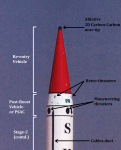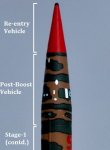Dude , if you want that salty thing , in parting reply, in return, refer to post #33, my response have been summed up there for your knowledge.
Anyways have nice forumming. Bye for now.
At least make up your own replies.
B-bye!
Thrust cartridges for maneuvering the RV, I was just wondering of the challenges of delivering multiple payloads aboard a single RV, and the course stabilization changes that would be needed to once the payload progressively reduces. It would be a fun project to work on.
So you're referring to the Post-boost Vehicle maneuvering, which delivers multiple RVs. Let me first clarify a couple terms and concepts, which will be helpful for others as well.
1. Almost every modern ballistic missile (except SRBMs) today has a Post-boost Vehicle (PBV), regardless of being MIRVed. This small (axially liquid-propelled for MIRVed missiles) stage also carries the missile's guidance system. It performs the function of correcting the errors made during boost-phase, by using a liquid fuel thrusting mechanism on board. It also performs the function of changing trajectories for MIRV-injection.
2. The MIRV-bus is a sort of payload adapter, mounted on top of the PBV. The bus dispenses the MIRVs at precise points in space, as directed by the mission computer.
3. Usually, after the individual RVs are dispensed (either unitary ones directly from the PBV, or MIRVs from the MIRV-bus), they are spun-up for re-entry and remain on their trajectories throughout the rest of the (~80% of the total) flight. MIRVs of Minuteman-III, Trident-II etc are like that, once they are released on the correct trajectories, they remain on their path as they have no internal propulsion or guidance for making maneuvers. Lately, Russia has been making progress to maneuver individual RVs as well.
A really helpful video in this regard (watch from 3:30 onward):
The following image is of LGM-118 Peacekeeper's Post-Boost Vehicles. It was a 70-80s era MIRVed ICBM.
Notice those big spheres? They are metallic fuel/oxidizer tanks. The fuel is storable hypergolic hydrazine, and oxidizer is nitrogen tetraoxide. Both liquids are combustible using catalysts, without any need for ignition. This fuel/oxidizer combo is widely used by almost all missile powers.
Small thrusters mounted around the PBV use the mentioned fuel to maneuver the PBV in space. A larger axial engine (restartable for MIRVs) also uses the same fuel.
Now coming to how Pakistan does it, I cannot give you any links or credible online information about that. I can only assume that Pakistan does it the same way, since its the easiest. There's one difference though, the PBV is termed as Post-Separation Attitude Correction system (PSAC) by Pakistan for early BMs like Shaheen-I, Shaheen-II, Ghauri, since it doesn't have an axial engine (except for Shaheen-IA, III, Ababeel...they may have axial engines).
However, some evidence did come up a few years ago. Remember the 2012 Ghauri crash fiasco? It wasn't a crash, but thats a separate discussion. We know that the PBV or PSAC is supposed to jettison the RV(s) and re-enter (burn and crash). Some Indian forumer dissected the 'crash' images of what actually was the PSAC, and thought the missile had exploded or something. See the following images:
Notice anything similar to the Peacekeeper's PBV? There's your answer for the earlier question.
As far as the challenge of dispensing MIRVs is concerned, what's required is a thrusting system and closed-loop guidance of the PBV. I hope the Minuteman-III video explained the general idea quite well. A closed-loop system in space can handle the variation of payload (as MIRVs jettison one-by-one) relatively easily.
Other than that, hows life. Are you still super up to date on all launches and other developments or have you been an occasional browser?
Life's good. Yeah, more or less, you know me...can't resist this stuff. Which reminds me, people on your side have been super-active for the past couple of years. At this rate of making fire-crackers, the region will needs its own START-like Arms Reduction treaties, in a decade or two.









